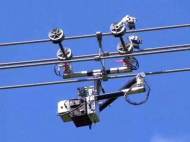HiBot’s robot Expliner could aid in aging power lines inspection
 In one of our previous articles we wrote about a robot developed to inspect the aging power lines in the USA, as well as about importance of preventive maintenance and inspection of the aging power lines. Many power lines in western Japan are 80 years old, so Tokyo-based HiBot worked with western Japan’s Kansai Electric Power Co. in order to create a robot that can inspect several power cables at once.
In one of our previous articles we wrote about a robot developed to inspect the aging power lines in the USA, as well as about importance of preventive maintenance and inspection of the aging power lines. Many power lines in western Japan are 80 years old, so Tokyo-based HiBot worked with western Japan’s Kansai Electric Power Co. in order to create a robot that can inspect several power cables at once.
HiBot’s inspection robot, called Expliner, is designed to roll along a typical high-voltage “bundle” in Japan (a set of four cables held in place by half-meter-wide square-shaped spacers on approximately every 30 meters). However, it is also capable to be used on single and dual cables with a diameter between 24mm and 64mm (0.94 to 2.51 inches). It has been successfully tested on live wires of up to 500 kilovolts, the maximum voltage pulsing through Japanese transmission lines. Its average time of operation was 6 hours.
On one of its sides the robot dangles a manipulator arm, which also serves as a counterweight for balance. It weights 80kg (176 pounds) and its dimensions are 1.5 x 0.6 x 1.5 meters (roughly 5 x 2 x 5 feet) when it’s in its compact posture. In order to inspect the cables, Expliner uses four sets of laser sensors (one set for each of the four cables in a bundle) which give the robot the ability to see the whole surface of each cable, to spot corrosion or scratches, and to discern tiny changes in cable diameter that could indicate damage inside the cable, such as a broken steel strand. The robot also has a high-definition, high-zoom camera that can record the details of bolts and spacers from its close range.
A big challenge for transmission-line robots is crossing obstacles that crop up on the line. Some obstacles, such as the cable spacers that keep bundled lines in place, are relatively easy to roll right over. Others, such as suspension clamps that hold up the line, block the way. Expliner gets around such things by using its dangling counterweight to shift the robot’s center of gravity, which in turn raises the wheels on the front and back axles up and out of the way of obstacles.
If the obstacle is more difficult, such as a steep incline in a mountainous region or a tower affixed to the line with more than a single simple insulator, the robot would still have to be brought down and installed on the other side of the obstacle. That’s not a problem since HiBot’s Expliner developers are not aiming to develop it as an autonomous robot. They will still rely on the line technicians who are trained to operate the robots from distances of up to 0.7 kilometers (0.43 miles).









Really a great invention. This robot seems to be great!
Hi,
there is a robot (LineScout) that has been in use on live power line for a few years now. It has won EEI 2010 Edison Award. A video of the technology is posted on YouTube:
http://www.youtube.com/watch?v=PEI5LlL0lBM
Very promising.
Mike